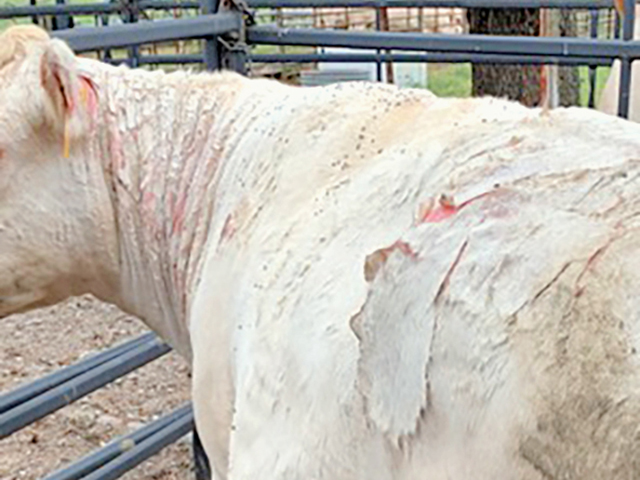Ask the Vet
Cattle Diet Is Primary Cause of Photosensitization
Reader: We had a Charolais cow with large patches of skin on her head and back. They are scabbed over and look like they are peeling up around the edges. She is in good body condition and does not seem sick. What could this be?
Dr. McMillan: This sounds like photosensitization. I have described it in this column before as a chemical sunburn. It is more common on light skin and mucus membranes.
There are two forms of photosensitization. Primary photosensitization is due to consumption of a plant that contains photodynamic agents. These are absorbed into the bloodstream and travel to the skin. Ultraviolet (UV) light activates them and creates a severe inflammatory reaction in the skin. Plants most commonly associated with this condition include St. John's wort, buckwheat and smartweed.
P[L1] D[0x0] M[300x250] OOP[F] ADUNIT[] T[]
Secondary photosensitization is far and away the most common form we see. With this condition, the liver is damaged from something the animal ate or some type of liver disease. Chlorophyll from plants the cow eats is broken down into phylloerythrin and excreted by the liver in bile. With liver damage, phylloerythrin builds up in the bloodstream and the skin. It is activated in the skin by UV light, creating skin lesions. Plants most associated with this form include alsike clover, comfrey, rattlebox, fiddleneck and ragwort.
Treatment involves removing animals from the pastures containing the plants causing the problem and protecting them from sunlight. If the teats of cows are affected, they may not allow calves to nurse. In those cases, calves will need supplementation until the cows recover. In some cases, antibiotics may be needed if skin becomes infected.
Reader: I always give my calves a blackleg shot and tag them at birth, but a friend says I'm wasting my money. He says they are protected from disease by colostrum they get from their mama, and this even interferes with the vaccines working properly.
Dr. McMillan: Let's review how the immune system works in young animals. In the first weeks of life, calves get antibodies (IgG) from their dams' colostrum to protect them from disease. This is passive or "maternal immunity." Think of this as an hourglass of antibodies. The amount of antibodies in that hourglass depends on four things: the level of immunity a dam has to a disease, the quality of her colostrum, how much colostrum her calf ingests and how soon after birth it ingests it. After 24 hours, that hourglass is empty, and from that point on, protection the calf gets from the dam steadily declines.
Maternal antibodies kill disease organisms, and, yes, they will destroy vaccines. Before a calf can respond to a vaccine, the antibodies in this imaginary hourglass must drop low enough to allow that response. This means every calf goes through a period when it is vulnerable. Fortunately, vaccines are just one tool to maintain health. Nutrition, parasite control, minimizing stress, biosecurity and sanitation are also key ways to avoid diseases.
One way around vaccine interference from maternal immunity is the use of intranasal vaccines. These vaccines are given in the nose and absorbed by mucosal surfaces that have immunologically active tissues that produce a different antibody called "IgA." Maternal IgA disappears quickly after birth, so this area of the immune system can respond to a vaccine early in life. Since most respiratory diseases enter through the respiratory tract, this protection is very effective in preventing these types diseases. Intranasal vaccines are noted for their rapid response, but typically, they do have a shorter duration of immunity compared to injectables. They are safe for use in pregnant cows and for nursing calves.
If you have good herd immunity, and your cattle are on a good plane of nutrition, vaccination at birth is probably not necessary. That said, clostridial vaccines are cheap. Properly handle them and follow BQA guidelines, and there should be no harm; some experts even recommended the practice.
> Please contact your veterinarian with questions pertaining to the health of your herd. Every operation is unique, and the information in this column does not pertain to all situations. This is not intended as medical advice but is purely for informational purposes.
> Write Dr. Ken McMillan at Ask The Vet, 2204 Lakeshore Dr., Suite 415, Birmingham, AL 35209, or email vet@progressivefarmer.com.
[PF_1120]
(c) Copyright 2020 DTN, LLC. All rights reserved.



